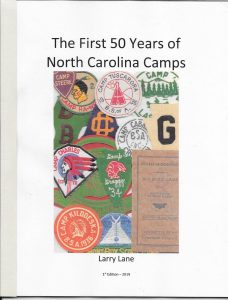1910 – 1960 North Carolina Boy Scout Camp Insignia
North Carolina Boy Scout Camps - The First Fifty Years
Larry Lane recorded a 15 minute PowerPoint presentation on the early history of Boy Scout camps in North Carolina (video link below!). Here is a summary of his findings. Please watch the video to see some great images he included.
Types of Councils
In the early days of the Boy Scouts of America (BSA) there were two types of councils for local organization of the movement. A Type 1 council had a paid professional on staff which typically meant a higher level of resources and therefore unified program was being offered. However, in North Carolina during the early days most councils fell into the category of a Type 2 council which meant only volunteers were running the show. How this affected program and therefore camps was that during the period of 1910-1920 in North Carolina the summer camps were privately run. In some cases the Scouts used a YMCA camp (Penton is an example) or troops hosted their own small camps on private land. It was quite an investment to purchase land and organize a permanent camp and these small young councils just weren't developed enough in the first decade of Scouting to pull this off.
1920-1930 First Council Run Camps
The second decade of Scouting in North Carolina saw several council organized summer camps operate. These first ones include Camp Tuscarora, Camp Oklawaha and Camp Oettinger. Interestingly the insignia that these camps issued was often designed as part of an honor camper award. Some camps developed complex point systems with different levels for achievement during the camp. For collectors keeping an eye out for memorabilia so far there are no known insignia from these camps that still exists.
1930 - 1938 Summer Camps In Session
During the 1930s many councils ran summer camps and issued felt patches which still exist in collections today. Some of the camps that ran in North Carolina include Camp Lasater, Camp Greysone, Camp Craggy, Camp Cherokee and Camp Daniel Boone. Beginning in the 1930s there are also other types of memorabilia produced including contest medals that sometimes show up in collections.
WWII Period For Summer Camps
Boy Scout Summer camps still ran during the war era although in some cases this was limited by gas rationing. East Carolina Council however did suspend it's summer camp operation during the 1940s and pivoted to a camporee style program. For memorabilia collectors during this period some patches were made out of a composite leather type material instead of the traditional felt.
Camp Honor Societies
Many camps formed some version of a summer camp honor society. In the 1930s a very popular honor society formed in Cincinnati, OH called the Ku-Ni-Eh was present in the Cape Fear Area Council (Wilmington), Occoneechee Council (Raleigh) and Tuscarora Council (Goldsboro). The Ku-Ni-Eh was based on Native American themes and at it's height was used in around 250 Boy Scout councils across the country. It's symbol of a rising sun was called a We-Hin-Ah-Pay. Mecklenburg County Council (Charlotte) and Central North Carolina (Albemarle) had their own home grown society known as the Order of the Pawnee. The East Carolina Council (Greenville) created a program called Croatan Indian Lodge. Generically these groups recognized exemplary campers at the end of their week of camp and inducted them in some form of Native American symbolic ceremony. Eventually in the 1940s these all became part of the Order of the Arrow (formed in 1915) as the BSA's official honor organization.
Segregated Scout Camps
During the long decades of segregation in America there was a very active Scouting program for African-American and Native American Scouts. However, the social policy of the day meant that separate facilities were made for those Scouts to be able to have a summer camp experience. In some cases the black Scouts would come to the same property after the regular season had ended and the camp would have a different name for that week. However, in North Carolina a different property was often utilized by the councils to run a summer program for minority Scouts. Some of the camps that ran during a span from the 1930s until segregation ended in 1972 were Camp Carlson (1936-1966), Camp James (1942-1971), Camp Ha-Whi-Ni (1943-1963), Camp Oak (1946-1966), Camp Robert Vaughn and Camp Hugh Reid Scott. By 1972 this policy had been scrapped and summer camps were integrated.
1950s Summer Camps Running Strong
Recovering from the war every council in North Carolina ran summer camp programs during the 1950s. For collectors during this time there was a change over to embroidered twill patches and often times silk screened neckerchiefs. There is a great variety of memorabilia issued during this time that is very fun to collect.
IF YOU HAVE ANY PAPERWORK FROM THIS TIME PERIOD WITH MORE HISTORICAL INFORMATION ON THESE CAMPS PLEASE REACH OUT! MANY COLLECTORS IN NORTH CAROLINA ARE PASSIONATE ABOUT KEEPING THE HISTORY OF SCOUTING DOCUMENTED AND ANY PRIMARY RESOURCES ARE APPRECIATED.
Larry Lane has written a book documenting the early North Carolina Council camps. This full color book is in my reference library and I definitely recommend it for anybody interested in this topic. You can purchase it on eBay in his store.



